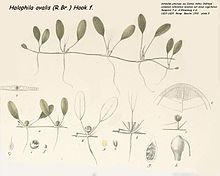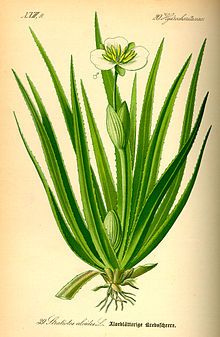Frog-bite family
| Frog-bite family | ||||||||||||
|---|---|---|---|---|---|---|---|---|---|---|---|---|

Frog bite ( Hydrocharis morsus-ranae ), illustration |
||||||||||||
| Systematics | ||||||||||||
|
||||||||||||
| Scientific name | ||||||||||||
| Hydrocharitaceae | ||||||||||||
| Yuss. |
The frog-bite family (Hydrocharitaceae) are a family in the order of the Alismatales within the monocotyledons . It is divided into four subfamilies and contains 16 to 18 genera with 116 to 120 species. They thrive in fresh and salt water from the temperate latitudes to the tropics . Some species are used as ornamental plants in ponds or aquariums .
Description and ecology




Appearance and leaves
They are annual to mostly herbaceous plants . They thrive as swamp, floating leaf or mostly underwater plants in fresh to salt water. They often form rhizomes or stolons with which they are anchored in the water bed. Some species are free-floating. They are more or less strongly submerged , vegetative parts of the plant rarely protrude above the water surface.
The leaves are opposite, alternate or whorled, basal or distributed on the stem. There may be petioles. The leaf sheaths are open. The leaf blades are parallel-veined and their shape varies greatly depending on the species. There are scales in the leaf axils.
Inflorescences and flowers
They can be single- sexed ( monoecious ) or dioecious ( dioecious ). The flowers stand individually or in zymose inflorescences . The flowers stand over a single spathe-like bract , which usually arises from two intergrown bracts or there are two free bracts.
Their radial symmetry , threefold flowers are mostly unisexual or rarely hermaphroditic. There are originally two circles, each with three free bracts ; they are white, yellow, red, purple or blue and mostly divided into calyx and crown, with some taxa the petals are missing. The male flowers contain one, two or many (up to 100 then at most 25 are fertile ) stamens . In the female flowers two to 20 are carpels to under permanent ovary grown, with the same number of punches like carpels. The scars are twofold. The unicameral ovary contains many orthotropic to anatropic, upright to pendulous, bitegmic ovules in parietal placentation . Pollination is rarely done by insects ( entomophilia ). Most of the pollination occurs through the water, sometimes through floating male flowers.
Fruits and seeds
Dry or berry-like capsule fruits are formed with many mostly small seeds. The fruits ripen under water. The diaspores spread through the water. The seeds often have a warty or reticulate surface.
Chromosomes
The chromosomes (0.8 to) usually 2 to 10 µm long. The basic chromosome numbers are x = 7 to 12. Polyploidy occurs.





Systematics
Within the order of the Alismatales , Hydrocharitaceae are the sister group of the Butomaceae .
The family Hydrocharitaceae was published in 1789 by Antoine Laurent de Jussieu under the name Hydrocharides in Genera Plantarum , 67. Type genus is Hydrocharis L. Synonyms for Hydrocharitaceae Juss. are: Blyxaceae Nakai , Elodeaceae Dumort. , Enhalaceae Nakai , Halophilaceae J.Agardh , Hydrillaceae Prantl , Najadaceae Juss. nom. cons., Stratiotaceae Schultz Sch. , Thalassiaceae Nakai , Vallisneriaceae Link .
The family of Hydrocharitaceae is according to Les et al. 2006 and the Angiosperm Phylogeny Website divided into four subfamilies with 16 to 18 genera and about (80 to) 120 species:
- Subfamily Anacharidoideae Thomé : It contains about eight genera with up to 54 species:
-
Apalanthe Planch. (It isputto Elodea by some authors): It contains only one or up to three species:
- Apalanthe granatensis (Kunth) Planch. (Syn .: Elodea granatensis Humboldt & Bonpland ): It thrives in freshwater in tropical South America.
-
Appertiella C.DKCook & Triest : It contains only one type:
- Appertiella hexandra C.DKCook & Triest : It occurs in west-southwest Madagascar.
- Blyxa Noronha ex Thouars (Syn .: Diplosiphon . Decne , Hydrotrophus C.B.Clarke , Enhydrias . Ridl , Blyxopsis Kuntze ): The eleven to thirteen species are common in the subtropics to tropical Africa, Madagascar, Asia and Australia.
- Egeria Planch. : The only two or three types are originallywidespreadin the New World . They are neophytes in many areas of the Old World .
- Waterweed ( Elodea Michx. , Syn .: Anacharis Rich. , Udora Nutt. ): The six or so species are originally widespread in the New World. Three types are neophytes in Europe.
-
Sparkle waterweed ( Lagarosiphon Harv. ): The about nine species are widespread in Africa and Madagascar, including:
- Lagarosiphon cordofanus Caspary : It occurs from Cameroon to Ethiopia and Namibia.
- Wechselblatt waterweed or large water garland ( Lagarosiphon major (Ridl.) Moss ): It is a neophyte in Western Europe and New Zealand in places . The "greater waterweed" is native to southern tropical and southern Africa.
- Madagascan water garland ( Lagarosiphon madagascariensis Casp .; Syn .: Lagarosiphon densus ): It occurs in Madagascar.
- Moss-like water garland ( Lagarosiphon muscoides Harv. ): It is common in tropical and southern Africa.
-
Nechamandra Planch. : It contains only one type:
- Nechamandra alternifolia (Roxburgh ex R.Wight) Thwaites (Syn .: Vallisneria alternifolia Roxburgh ex R. Wight , Lagarosiphon alternifolia (Roxb. Ex R.Wight) Druce , Nechamandra roxburghii Planchon ): It is originally widespread from the subcontinent India to southeastern China .
- Ottelia Pers. (Syn .: Beneditaea Toledo , Boottia Wall. , Oligolobos Gagnep. , Xystrolobos Gagnep. ): The approximately 21 species are distributed from tropical to southern Africa and Madagascar, in Asia and Australia, and from Brazil to northeastern Argentina. One species ( Ottelia alismoides (L.) Pers. ) Has become naturalized in rice fields in northern Italy.
-
Apalanthe Planch. (It isputto Elodea by some authors): It contains only one or up to three species:
- Subfamily Hydrilloideae Luerssen : It contains about six genera with about 61 species:
-
Enhalus Rich. : It contains only one type:
- Enhalus acoroides (L. f.) Rich. ex Steudel (Syn .: Statiotes acoroides L. f. , Enhalus koenigii Rich. ): It thrives along the coasts of the Indian and western Pacific Oceans and on the islands in between, as well as from Somalia to northern Mozambique and on the southwestern Arabian Peninsula .
- Halophila Thouars : The approximately 19 species are originally widespread on the coasts of the Pacific, the Indian Ocean and the Caribbean. One species in some coastal areas is a neophyte .
-
Hydrilla Rich. : It contains only one type:
- Ground nettle ( Hydrilla verticillata (L. f.) Royle ): It is widespread in Eurasia, Africa and Australia. In Central America she is a neophyte.
- Mermaid herbs ( Najas L. ): The approximately 40 species are distributed almost worldwide.
- Thalassia Banks & Sol. ex KDKoenig : The only two species thrive along the coasts of the Caribbean Sea, the Gulf of Mexico, the Indian and the western Pacific Ocean.
- Vallisneria L. also called Vallisneria or water screws: The approximately 14 (8 to 26) species are distributed almost worldwide. Some species are used as aquarium plants. Vallisneria spiralis is an invasive plant in many areas.
-
Enhalus Rich. : It contains only one type:
- Subfamily Hydrocharitoideae Eaton : It contains two genera with about five species:
- Hydrocharis L .: The only three species are common in the ancient world.
- Limnobium Rich. : The only two species are common in the fresh water of the New World.
- Subfamily Stratiotoideae Luerssen : It contains only one monotypic genus:
-
Stratiotes L .: It contains only one species:
- Crab claw ( Stratiotes aloides L. ): It is widespread from Europe to Central Asia.
-
Stratiotes L .: It contains only one species:
swell
- The family of Hydrocharitaceae in APWebsite. (Sections description, systematics)
- Robert R. Haynes: Hydrocharitaceae. - Same text online as the printed work , In: Flora of North America Editorial Committee (Ed.): Flora of North America North of Mexico. Volume 22: Magnoliophyta: Alismatidae, Arecidae, Commelinidae (in part), and Zingiberidae , Oxford University Press, New York and Oxford, 2000, ISBN 0-19-513729-9 (section description)
- Wang Qingfeng, Robert R. Haynes, C. Barre Hellquist: Hydrocharitaceae . In: Wu Zheng-yi, Peter H. Raven & Deyuan Hong (Eds.): Flora of China . Acoraceae-Cyperaceae. Volume 23. Science Press and Missouri Botanical Garden Press, Beijing and St. Louis 2010, ISBN 978-1-930723-99-3 , pp. 91 (English, Hydrocharitaceae - online text is identical to the printed work - online text is identical to the printed work). (Sections Description, Systematics and Distribution)
- Abdul Ghafoor: Hydrocharitaceae at Tropicos.org. In: Flora of Pakistan . Missouri Botanical Garden, St. Louis (Description Section)
- Leslie Watson: Hydrocharitaceae. Western Australian Flora Online . (Section description)
- Anna Haigh, 2009: Neotropical Hydrocharitaceae. In: Neotropikey - Interactive key and information resources for flowering plants of the Neotropics .
- Donald H. Les, Michael L. Moody, CL Soros: A reappraisal of phylogenetic relationships in the monocotyledon family Hydrocharitaceae (Alismatidae). In: Aliso. Volume 22, 2006, pp. 211-230.
- Ling-Yun Chen, Jin-Ming Chen, Robert W. Gituru, Qing-Feng Wang: Generic phylogeny, historical biogeography and character evolution of the cosmopolitan aquatic plant family Hydrocharitaceae . In: BMC Evolutionary Biology . tape 12 , no. 1 , 2012, ISSN 1471-2148 , p. 30 , doi : 10.1186 / 1471-2148-12-30 (English, biomedcentral.com ).
Individual evidence
- ↑ a b c d e Ling-Yun Chen, Jin-Ming Chen, Robert W. Gituru, Qing-Feng Wang: Generic phylogeny, historical biogeography and character evolution of the cosmopolitan aquatic plant family Hydrocharitaceae . In: BMC Evolutionary Biology . tape 12 , no. 1 , 2012, ISSN 1471-2148 , p. 30 , doi : 10.1186 / 1471-2148-12-30 (English, biomedcentral.com ).
- ↑ Leslie Watson: Hydrocharitaceae. Western Australian Flora Online .
- ↑ a b c d e f g h i j k l m n o p q r s Rafaël Govaerts (Ed.): Hydrocharitaceae. In: World Checklist of Selected Plant Families (WCSP) - The Board of Trustees of the Royal Botanic Gardens, Kew . Retrieved April 22, 2020.
- ^ Hydrocharitaceae at Tropicos.org. In: IPCN Chromosome Reports . Missouri Botanical Garden, St. Louis
- ^ Hydrocharitaceae at Tropicos.org. Missouri Botanical Garden, St. Louis, accessed July 3, 2014.
- ^ A b Hydrocharitaceae in the Germplasm Resources Information Network (GRIN), USDA , ARS , National Genetic Resources Program. National Germplasm Resources Laboratory, Beltsville, Maryland. Retrieved July 3, 2014.
- ↑ Christel Kasselmann : aquarium plants. Ulmer Verlag, Stuttgart 1995; 2nd, revised and expanded edition 1999, ISBN 3-8001-7454-5 , p. 444.
- ↑ a b c d Walter Erhardt , Erich Götz, Nils Bödeker, Siegmund Seybold: The great pikeperch. Encyclopedia of Plant Names. Volume 2. Types and varieties. Eugen Ulmer, Stuttgart (Hohenheim) 2008, ISBN 978-3-8001-5406-7 .
- ↑ Christel Kasselmann (1999), p. 319.
- ↑ Christel Kasselmann (1999), p. 321.
- ^ Hans-Georg Kramer: Plant aquaristics á la Kramer. Tetra-Verlag, Berlin-Velten 2009, ISBN 978-3-89745-190-2 , p. 160 f. (Madagascar "waterweed").
- ^ Hydrocharitaceae at Tropicos.org. In: Catalog of the Vascular Plants of Madagascar . Missouri Botanical Garden, St. Louis
- ↑ a b James Edgar Dandy : Ottelia Pers. or Blyxa Noronha ex Thouars , or Halophila Thouars. In: TG Tutin, VH Heywood, NA Burges, DM Moore, DH Valentine, SM Walters, DA Webb (eds.): Flora Europaea . Volume 5: Alismataceae to Orchidaceae (Monocotyledones) . Cambridge University Press, Cambridge 1980, ISBN 0-521-20108-X , pp. 4–5 (English, limited preview in Google Book Search).
- Jump up ↑ Donald H. Les, Surrey WL Jacobs, Nicholas P. Tippery, Lei Chen, Michael L. Moody, Maike Wilstermann-Hildebrand: Systematics of Vallisneria (Hydrocharitaceae). In: Systematic Botany. Volume 33, Issue 1, 2008, pp. 49-65.